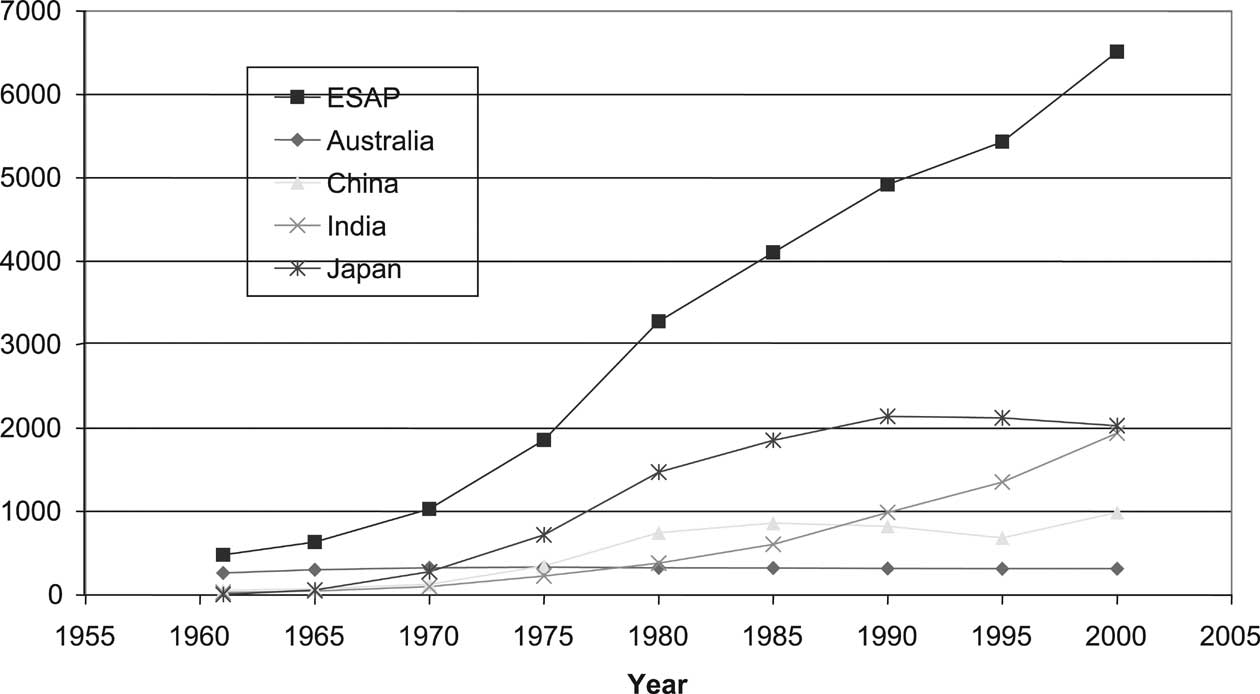three more semidwarf cultivars, IR5, IR20 and IR22, were released during the 1960s, followed by another 17 in the 1970s and 13 during the 1980s (Peng and Khush, 2003). The release of IR8 increased the yield potential of tropical rice from 6 to 10 tonnes ha-1. Its yield potential has hardly been surpassed in 40 years of breeding (Peng et al., 1999). The development of early-maturing varieties, particularly in rice, has enabled double and triple cropping in areas that previously produced only one or two crops a year. The dwarf varieties, less prone to lodging, could be grown more densely, using a smaller area (Robinson, 1996).
By 1970 almost all the area under high-yield seeds, about 94% of wheat and 98% of rice, was in Asia, of which nearly half was in India (Pearce, 1980). The maximum effect of the high-yield variety program in India was in wheat, where the coverage was 83% of the cropped area by 1985/1986. Rice was next, with about 57%. Coverage under cereals ranged between 30 and 46% (Groosman et al., 1991). Seed supply systems of new varieties replaced the traditional varieties.
High-yield wheat and rice were critically dependent on several inputs, so there was an increase in agroindustry. For example, in India, nitrogen fertilizer production increased from 0.37 million tonnes in 1967/1968 to 2.23 million tonnes in 1979/1980. Furthermore, production capacity had to be generated for tractors and other machines. Farmers had to invest their own capital to acquire these machines, which were often produced with the help of public financing agencies (Chaboussou, 2004).
Amid the wave of the Green Revolution, Chinese scientists led by Professor Yuan Longping bred the world's first rice hybrid in 1974. Hybrid rice yields about 15 to 20% more than the best of the improved or high-yielding varieties. By 2000, about half of China's total rice area was under hybrid rice cultivation. National average rice yields increased from 3.5 to 6.2 tonnes ha-1 between 1975 and 2000. Hybrid rice has particularly good potential to improve the food security of poor countries with scarce arable land, expanding populations and cheap labor. FAO, IRRI, the United Nations Development Programme (UNDP) and |
|
the Asian Development Bank supported improving national capacity in hybrid rice development and dissemination outside China (FAO, 2004).
2.2.2.2 Mechanization
Agricultural machinery is another modern technology that has contributed greatly to farming and crop production. Advances in farm machinery have changed the way people produce food worldwide. Agricultural machinery entails substantial cost to buy and operate but reduces labor considerably.
Rising wages and reduced availability of labor in many Asian countries forced farmers to mechanize, adjust cropping patterns and resort to migrant labor. In some cases, these changes were extraordinarily rapid. In the Central Plain of Thailand, the labor used in irrigated rice cultivation had declined from 57.5 person days per hectare in 1987 to just 8 person days by 1998, a decline of 86% in little more than a decade (Isvilanonda et al., 2000). The reduced labor was by mechanizing harvesting and switching from transplanting to direct seeding. Rapid changes occurred in southern China, where many farmers changed from triple cropping (rice-rice-winter crop) to a single rice crop to save labor.
Farmers often could not afford to buy agricultural machinery, so well-functioning rental markets were crucial. For example, while combine harvesting was widespread in the Central Plain of Thailand, only a small percentage of farmers owned a combine harvester. Use by owners, plus rental through cooperatives or government agencies, accounted for just 6% of use; the rest occurred in private rentals (Dawe, 2005). Rental markets often arose naturally in the absence of government restrictions.
Tractors were the most common machinery. The number of agricultural tractors in ESAP expanded rapidly, reaching 6.5 million in 2005 (Figure 2-2). It increased 14-fold from 1961 to 2005. Japan, with the most tractors in use, started mechanizing early. India's use of tractors increased rapidly, overtaking China in the 1980s and reaching a level |

